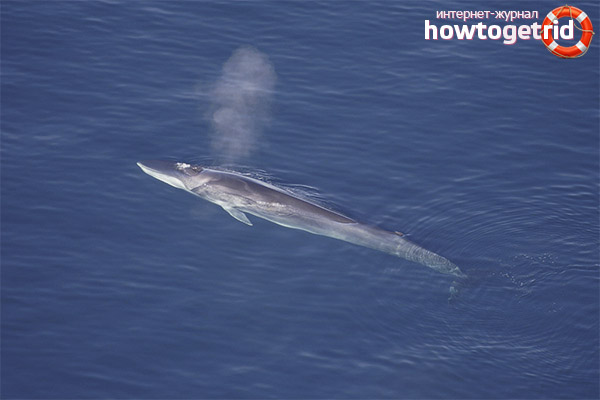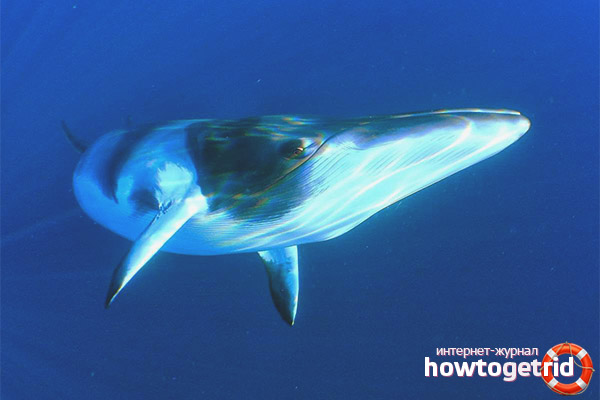The content of the article
Finwal is a mammal belonging to the order of cetaceans. They belong to the family of minke whales. Finials are very large animals. They occupy the second largest place on the planet, second only to the blue whale. Representatives of the species can grow in length by more than 27.3 m. Their weight can be about 70 tons or more.
Appearance
These huge mammals grow on average up to 20 m. Their mass varies between 40-70 tons. Their sizes, as a rule, depend on the habitat. Individuals that live in the southern hemisphere usually do not grow more than 20 m in length. Those whales that live in the north and in the Arctic can have a length of more than 25 m. Females almost do not differ in appearance from females. Adult individuals of both sexes will have almost the same weight and dimensions. Sometimes the body of the females is slightly longer.
The main difference between the representatives of this species from other whales is their asymmetric coloration. In the area of the lower jaw they have a white color on the right side. And on the left - darker. In these animals, the base of the tail is directed upward. The dorsal fin is curved in the direction of the tail. Usually its length is approximately 50 cm. Finwal has a flat head. It makes up approximately 1/5 of the entire body length of the animal. While eating these whales widen their mouths. From the navel to the lower jaw, they have a lot of folds. Due to them, the mouth expands. In addition, in the process of eating food, thanks to them, water passes through the mouth. To capture and weed out small prey, the whale uses its mustache. At finals, it consists of several hundred plates.
Where dwells
In the North Atlantic Ocean, the species live near the coast of North America, as well as near Iceland and Norway. A lot of them off the coast of Greenland. In winter, they live everywhere, from the Gulf of Mexico to Spain, as well as off the southern coast of Norway.
Those populations that live in the southern hemisphere are constantly migrating. The largest and oldest of them usually swim much south.
The habitual habitat for finials is the zones of the polar as well as temperate climate. Occasionally they can be found in tropical seas. Finns live in coastal waters, usually where the depth is 200 m or more.
Nutrition
The finals' nutrition is based on the small inhabitants of the world's oceans. It can be squids, various fish and crustaceans. They extract food from water by filtration.
Behavior

Finals are considered one of the most sociable among all whales. They live in groups that are a family of 7-10 individuals. During migration or near the feeding area, they can gather in larger groups - about 250 individuals.In the spring and autumn, they prefer to migrate to cooler waters. In the fall, they return to their usual habitats where mating takes place. Finials are known for being able to reach higher speeds. Among marine mammals, they are one of the fastest. Sometimes they reach speeds of up to 25 mph. Under water, they are able to remain for 15 minutes, diving 250 meters in depth.
Males are capable of making very low sounds. Such low frequencies can reproduce only some animals on the entire planet. Vocalization is the main way of communication for finials. This is also true for other species of whales. The frequency of the emitted sounds is 16-40 Hz. A person cannot hear them.
Breeding
Researchers suggest that these animals are monogamous, and during the breeding season they find a mate. It was noticed that courtship was characteristic of them at this time. The male begins to pursue the female, while issuing various low frequency vocalizations. These sounds are similar to those made by the humpback whale. But they are more complex. As a result of one of the studies, it was found that only males of this species can make such low sounds. Low-frequency sounds are used by finials in order to spread them as far as possible in the water column. The female can hear them even if she is very far away. Finding and hearing each other is very important for them, because they do not have specific mating places. To find each other, they need this way of communication from a distance.
Mating, as well as the birth of offspring, falls on the last month of autumn and the very beginning of winter. During this period, populations live in warm water. Pregnancy can last 11 months or a little longer. The female brings posterity every 2-3 years. As a rule, 1 cub is born. Sometimes there are 2, but in this case the offspring is very weak, and often dies. Before the new mating, the female finwala rests for six months. If during the breeding season she is not pregnant, she rests for about 6 months.
Representatives of the species reach maturity at 4-8 years. At the same time, males grow up to 18.5 m in length, and females grow up to almost 20 m. But their body reaches its maximum length in about 22-25 years. At this age, the physical maturity of individuals begins. About six months later, the female feeds the cub with her milk. A small finwal cannot suck mother’s milk in the usual way, so the mother injects it into his mouth. At the same time, she contracts her circular muscles located at the edge of the nipple. Feeding occurs throughout the day every 10-12 minutes.
On average, representatives of this species live for approximately 95 years. But some individuals can live even more than 100 years.
Enemies

Adults have no enemies in nature. But in the 1st half of the 20th century, these whales were ruthlessly hunted by people who brought the species to almost complete extinction. In the 50s, about 10 thousand individuals were caught annually. Young individuals sometimes become victims of large predators. Orcas attack them. But since finwaels usually live in groups, older individuals protect them.
The contribution of finwales to the ecosystem lies in the fact that they use plankton in huge quantities. A lot of parasites live on their bodies. These are various lice, worms, and also mollusks.
Economic importance
Humans have been hunting these whales for centuries. They used all parts of their body that were food, fuel, and even building materials. Finns do not play a negative economic role for humanity.
Security
These animals often collide with ships, causing serious injuries. Most often this happens in the waters of the Mediterranean Sea. It is here that such cases are the main cause of death of whales. On the eastern shores of the United States in 2000-2004, 5 such clashes were recorded that led to the death of animals. Sometimes whales die when caught in fishing nets.
Since 1976, it has been prohibited to catch finials in the North Pacific Ocean, as well as throughout the southern hemisphere. This ban was passed by the International Whaling Commission. The purpose of the ban is to restore the number of finals. In the northern Atlantic, hunting was stopped only in 1990. It is noteworthy that for indigenous people who live on the territory of Greenland, there are exceptions to fishing for these whales. In Iceland, they began to be caught again in 2006 on an industrial scale, and in 2005 in Japan for scientific purposes.
Video: whale finwal (Balaenoptera physalus)










Submit